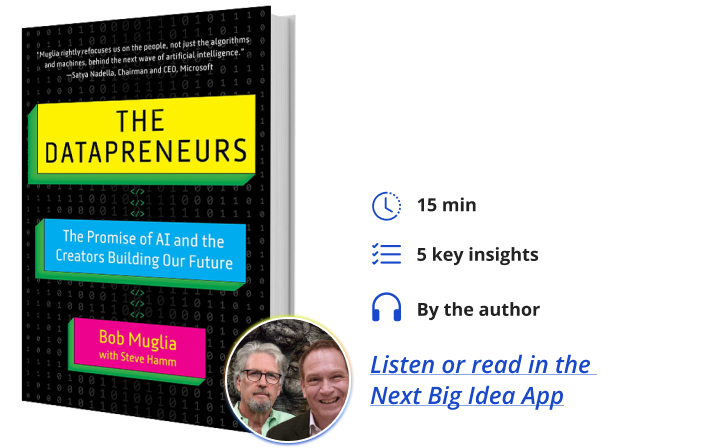Bob Muglia is an American business executive and research and development specialist. He was formerly the Chief Executive Officer of Snowflake Computing, a data warehousing startup.
Steve Hamm is a writer and documentary filmmaker. He spent more than a year as a journalist in Pivot Projects, a global collaboration focused on using collective intelligence, systems thinking and modeling, and AI research tools to help communities become more sustainable and resilient.
Below, Bob and Steve share 5 key insights from their new book, The Datapreneurs: The Promise of AI and the Creators Building Our Future. Listen to the audio version—read by Bob—in the Next Big Idea App.

1. The Arc of Data Innovation.
It certainly seems like technological changes are happening at an incredibly rapid pace right now. This has happened because of a long-term series of innovations that have occurred over the last 50 years in technology, particularly around data.
We’ve seen data progress from the earliest days of relational databases to the business systems that run business today to the use of the internet and the way we can share information. Building on the internet, the cloud, and the modern data stack have enabled companies to work with vast amounts of data.
All of that is coming together with increasing speed as we see AI progressing and taking our world into the future. This history over time also involves the people, the innovators, and the key innovations they have created. The tech and the people are what culminate and bring us to where we are today in the world of technology and AI.
2. The most important business assets are people and data.
The heart and soul of any company are their people and their data. People have been at the center of companies since the beginning of time and they’ve always played a key role in helping to serve customer’s needs. But in today’s modern world, data and information about your business and your customers are critical to the success of every company.
There have been key technical advances in the data world that have helped organizations to get more in touch with their customers. The people, the innovators, tell the story of the evolution of the data industry. And while the technology itself is important, it’s the thinkers who have imagined the newest technical innovations that are driving business today.
As we move forward, this combination of people, working together with technology, becomes even more important. Intelligent machines, powered by AI, will perform many tasks for us. But these machines will be guided by people and the values we instill in them. So now more than ever, it is really people, together with our values, that will determine our future
3. The importance of values.
Every company and organization needs to have a set of values that provide employees with that guidance for how they operate on a day-to-day basis. When an organization properly establishes a set of values, they provide some day-to-day description and advice to employees. These values help solve the daily problems that the company and its employees face.
At Snowflake, values were a very important part of what we did as a company, and they were part of our heart and soul. They were developed over a several-year process that was organic and included people throughout the organization. Once they were established, they were adopted deeply throughout the organization. As CEO, I reinforced the Snowflake values—in every team meeting as well as just about every discussion I had with employees.
“Machine learning will be programmed to operate based on the values of an organization.”
If treated seriously, values can provide honest guidance for companies to be successful with customers. At Snowflake, our first value was that we put our customers first—and it made a big difference in how the company operated. Putting our customers first was a value we lived every day.
Values are particularly important for technology organizations which today are providing services that deliver information to people on a day-to-day basis. The products and services that technology companies create are a product of the values of that organization—the company values are incorporated into the resulting service that we see on a day-to-day basis.
This will become even more true over time, as machine learning takes a broader and broader role in providing and delivering those services. Machine learning will be programmed to operate based on the values of an organization. So, establishing, explaining, and reinforcing strong cultural values are critically important for all technology companies. The technical organizations that are building this next generation of services, those services powered by AI, will shape our future.
4. A model-driven world.
A model is a representation of an idea or thing and encapsulates at least some of the knowledge required to create something. People have been modeling for centuries. Renaissance artists created models of their cathedrals and other masterpieces. A model could really be anything—instructions or a recipe, a sketch, a clay miniature, or the steps in a business process to close a sale.
Technology is impacting all aspects of business and in our lives. Most models today are created on computers. A computer model is a digital representation of the real world. Some of these models are very formal. Examples include the architectural drawings for a new building that is submitted to a city agency or the computer-aided design models for a new airplane wing or an electric car. But most models are pretty informal; they’re ideas created by people, often with very little documentation—the classic sketch on the back of a napkin, a picture of a whiteboard, or perhaps a document that describes a business process.
Every company uses software applications and a variety of tools to help them run their business. The software applications underlying these businesses contain business logic, the process by which businesses run. This logic is opaque to most people—they don’t really know how things work.
This is about to change. Machine learning and AI are a type of modeling that is being broadly applied across the industry. It uses statistics and probabilities to make predictions and help companies make decisions. These are models, and as they become more sophisticated over time, with more artificial intelligence applied, their ability to impact business is expanding.
We see this with the whole explosion of new ideas for AI products and services that have happened in the last few months. Now models that incorporate machine intelligence can help people in their jobs and their daily lives. This intelligence can be used to solve a variety of different problems. These new solutions require the combination of intelligence to execute an idea together with the knowledge needed to make it happen.
Knowledge is having sufficient information or data, together with its analysis and conclusions. In today’s world, this data comes in all forms—documents, web pages, relational databases, log files, pictures, videos, sensor data, you name it. Analysis turns data into knowledge, and knowledge can be applied to solve business problems.
“Technology is delivering a whole new generation of model-driven services that can intelligently help us to solve problems of all types.”
One particularly interesting form for knowledge is called a knowledge graph. A knowledge graph is a database that can represent things, events, concepts, and relationships and the relationships between them. As we try to represent more complex concepts within software, knowledge graphs provide a way to formally model them and describe them in a way that people can understand.
Perhaps more interestingly, a relational knowledge graph that is built using relational mathematics can allow these models to become fully executable. In other words, a businessperson can describe the process for a business, ultimately in a language that they understand such as English, and the system can execute that process directly.
This is how modeling is affecting the world. Technology is delivering a whole new generation of model-driven services that can intelligently help us to solve problems of all types. The combination of artificial intelligence models with the intelligence they deliver, together with the data and knowledge of all forms, will transform us from a software-driven world into a new future, a model-driven world.
5. Isaac Asimov was right.
Since late last year, we’ve seen tech companies announce a series of stunning advances in artificial intelligence. ChatGPT and then following that, GPT4, have shown new capabilities in machines that we never thought were possible. It’s now reasonable to believe that within the next few years, say within the next decade, we’ll see systems that demonstrate what’s called Artificial General Intelligence (AGI). In other words, machines that are as smart as an average person.
Industry leaders generally acknowledge that the government has a role to play in the regulation of artificial intelligence, but it’s not really clear what needs to be done and who should do it. How are we going to control and limit the use of AI by people who have malicious intentions? How do we regulate artificial intelligence as they get smarter and smarter without stunting innovation?
It’s interesting to look at the past. Particularly, we learn that Isaac Asimov really was a genius and a prophet. He had predicted much of what we now see today in his many robot novels and short stories. In his 1942 short story, “Runaround,” written before the advent of digital computers, he published what we now know as Asimov’s Three Laws of Robotics. The first law is a robot may not harm a human being or, through inaction, allow a human being to come to harm. The second law is a robot must obey orders given to it by human beings except where such orders would conflict with the first law. The third law is a robot must protect its own existence as long as such protection does not conflict with the first or second law.
As we look forward over the next few years, the artificial intelligence and services that are introduced will be tools created by people, just like the robots that Asimov predicted back in the 1940s. People will have different intentions and they will apply AI to just about every purpose—the good, the bad, and unfortunately, the evil. So, the companies and organizations that create these new AI services must assume responsibility for the actions that they perform.
Existing laws can be used with AI, and they can be applied to the people and the organizations responsible for AI systems. But they are insufficient to cover these new products. We can look to Asimov’s Laws of Robotics to provide us with guidance. We can build new legislation that’s targeted at covering the rules and regulations associated with how people apply AI to every possible purpose.
“How do we regulate artificial intelligence as they get smarter and smarter without stunting innovation?”
Asimov’s First Law prevents the creation of killer robots and suicide drones. This is an area where governments and organizations need to work together to deal with AI and see how it applies to warfare. Perhaps something similar to the United Nations treaty on the nonproliferation of nuclear weapons would be appropriate to limit and manage the use of killer robots by militaries and war.
There will be challenges and problems, but artificial intelligence is an incredible tool which will enrich people’s lives in ways that we can’t even predict right now. In fact, AI is going to change our lives in many ways. Ultimately, it looks like AI will continue to get smarter and become ultimately the equals of us, and perhaps ultimately have capabilities that vastly exceed us.
So as AI continues to grow in intelligence, how will we be able to control it? Again, we can look to Asimov for guidance. Later in his career, in his later robot novels, the robots became more sophisticated and some of them assumed the capabilities of an AGI. In fact, they played a very significant role in helping people to govern society. Because they were governed by the Three Laws, these robots had people’s best interests in mind and were benevolent. However, even those robots recognize that the three laws were insufficient.
Asimov later added what he called the Zeroth Law, which is a founding principle that we must apply to AGI’s and super-intelligent entities that we create in the future. Asimov’s Zeroth Law states that a robot may not harm humanity or, by inaction, allow humanity to come to harm.
This Zeroth Law raises a whole lot of questions. It requires governments to work together to build a social contract that ensures that the actions of intelligent machines are aligned with the well-being of humanity.
This starts by treating the entities that we create as our partners in the future. People decide what capabilities to provide these systems, and it’s critical that we put in place the mechanisms to ensure that control over time.
While the details are still unclear, I’m optimistic that that can be done. In fact, I’m confident that the world of robotics in the future can create a better world for us. I imagine a world of plenty where people have the opportunity to live happily and maximize their potential. The machines of the future can help us to achieve a better future for all of us. But it’s important that we recognize that this can only be done with regulations that are put in place. These regulations will help control and manage the systems and entities that mankind creates.
To listen to the audio version read by author Bob Muglia, download the Next Big Idea App today:






























